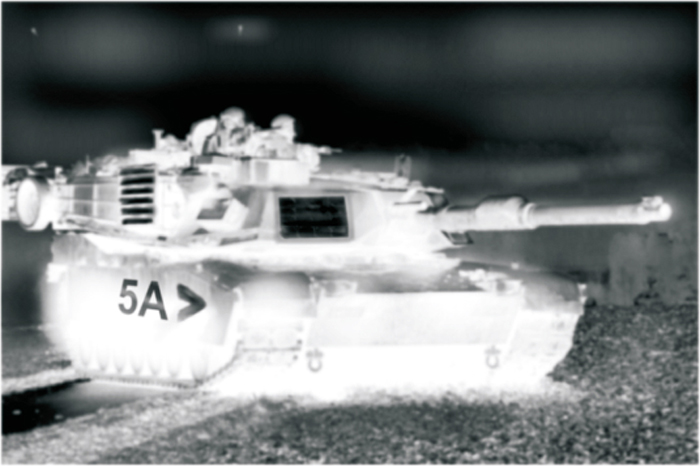Marking equipment and buildings
For visible and easy to use marking
Makes it easier to identify targets during training
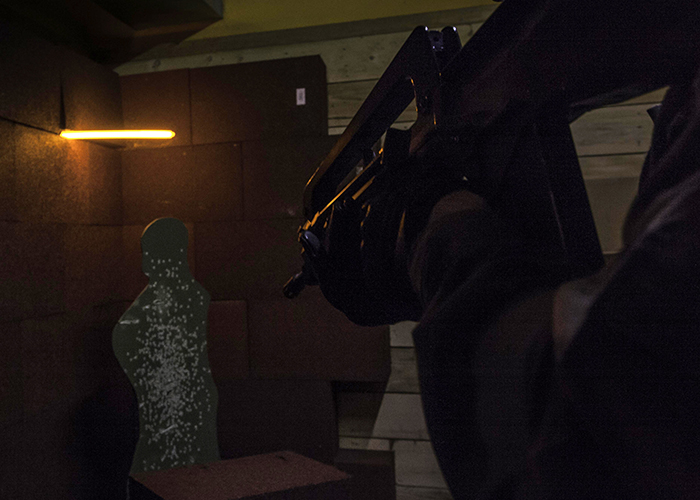
Target marking
We recommend several different Cyalume products that can be used for marking targets during night shooting exercises.
- 6″ (15cm) or 15″ (40cm) Cyalume light sticks can also be used by or 15'' (40cm) placing them directly under and in front of the target. They are quick and easy to use.
- The Lightshape circular adhesive patches come in an infrared version that can be easily attached to a target. They are quick and easy to use. Several IR patches can be used to outline the edges of the target. If, for example, the patch was hit by a ball, it would still continue to work. It is also possible to place several infrared patches behind the target in order to create a halo of light.
- The reflective infrared strips placed on the target can be positioned in a way that outlines the edges of the target. Even if these strips are hit by bullets, there will be no change to their properties or their effectiveness.
Marking crossings/passages
Cyalume sticks can be used for marking areas at night in order to identify passages and signal particular areas. Natural sites, obstacles and equipment on the field can be marked by using Cyalume products:
- Light signals at night used as semaphore signals.
- Construction of a bridge: Attach a Personal Marker (PML) in order to protect the lives of human beings, in this action.
- Bridge/ crossing: For faster crossing, use a color code so that the center, left and right of a bridge or bank can be identified.
- See antenna cables at night by attaching a 15cm light stick or LightShape marker to them.
- Marking out obstacles: Marking out verified passages. Obstacles can be marked with visible or IR markers.
- Detection of the presence of mines on the ground is increasing.
- Marking out areas where there is barbed wire: Use Flexbands in order to prevent soldiers from getting injured during training.
- Fill vehicules with fuel safely when in dark areas.
Cyalume sticks can be used to mark important passages
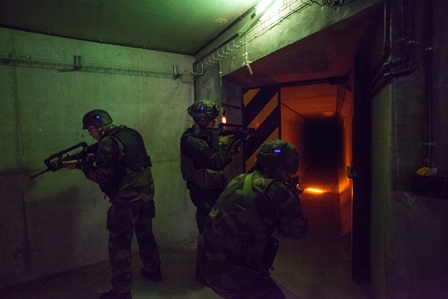
40cm Orange Ultra-High Intensity stick that turns as soon as there is any kind of impact with the ground.
Marking buildings in order to identify areas
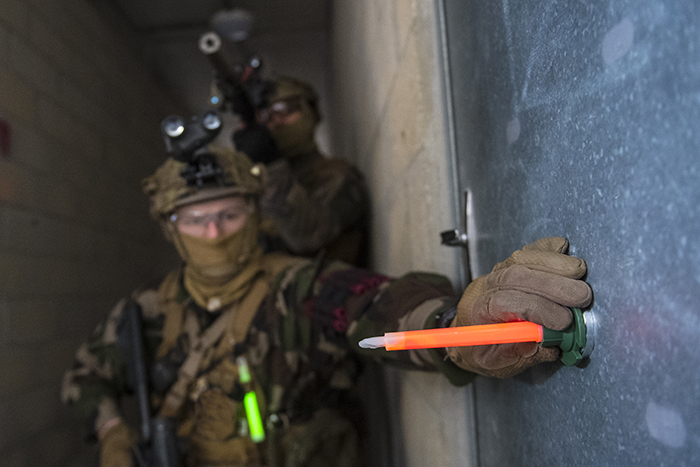
Regulatory building marking with light sticks
In terms of outdoor marking, there is a regulatory marking put in place in order to monitor buildings as well as underground progression (combat training in urban areas).
A pre-positioned badge at the entrance of a an area that needs to be monitored is activated at its exit. The color code will indicate the nature of the monitoring:
- red marking: can be used for a building that is in the process of being monitored. The colour red must appear as a mandatory entry point.
- green marking: can be used for a monitored building that has already been inspected
- blue marking: can be used to indicate the presence of a trap and/or obstacle inside the building
- yellow marking: can be used to indicate that a medical evacuation procedure such as EVASAN or MEDEVAC is required for an injured person who is located inside the building.
Colour combinations are also possible except for red and green, two colors which cannot be combined.
For these different types of marking, several different sizes of Cyalume light sticks can be used along with circular (Lightshape) patches/light markers. The advantage of these patches is that it is possible to write on them with a permanent marker.
In this way, colour marking can be done inside with markings that indicate:
- Entry point,
- Cleared room,
- Prisoners of war point,
- Point for the injured,
- EVASAN required,
- Trap,
- ammunition and/or obstacle in the room….
Identification and marking at sea ensures more safety and makes them easier to track
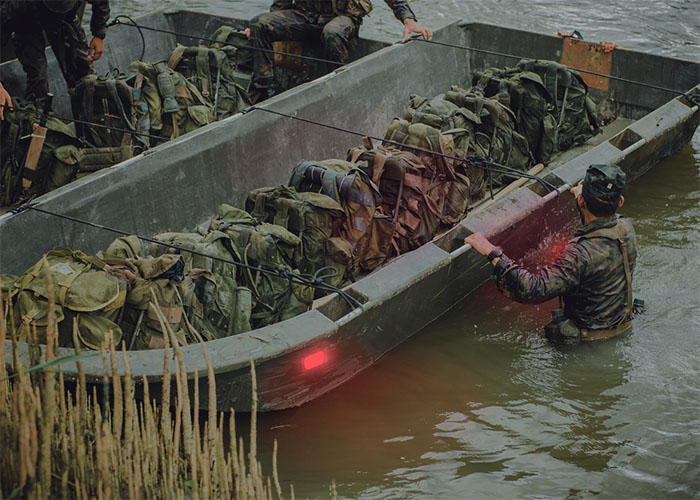
Identification of equipment during operations at sea
- Use 15″ (40cm) light sticks in order to identify packages dropped at sea
- Identification of night boats in order to track them at sea: Use raft equipment, life rafts and small inflatable boats at sea for SOS type distress signals (emergency light signal or emergency evacuation signal) in order to signal at sea in case of an emergency. The long SOS emergency signal strap can be attached to a light stick so that it rotates in the air and forms a light circle that can reach 5 km in aerial view. The SOS is a signal that sends out emergency calls for help at sea, in the mountains or in any remote area.
Both waterproof and buoyant, it is highly recommended for offshore operations. - Rescue at sea: each team member can be equipped with a PML personal light marker. It can be activated with one hand by pressing the handle. Attached to the lifejacket, it provides light for more than 8 hours and is visible for up to one mile at sea (1.6km) and it can also reach 5000 meters in aerial observation.
CyFlect retro-reflective and photoluminescent products can also help identify people, equipment and structural elements (steps, overdoors, etc.) at sea. Available in the form of strips with the design of a honeycomb, they can be sewn or attached to various substrates (e.g textiles, structural elements, etc.).
Marking diving equipment
- Diving light: Attach a 15cm light stick with a combat directional screen to the diving board containing the required information (depth, map, mine position, etc…)
- Marking the diver’s buoy
- Marking parachutes during diving operations
- Marking scuba tanks: place a light stick attached to a magnetic base on the scuba tank in order to identify the bottles left underwater in complete discretion
- Marking out the escape route in a submarine: the light sticks can be attached to the submarine’s escape hatches in order to indicate the route to the exit in the event of an emergency evacuation and/or power failure.
These markings can be made using 15cm or 40cm ChemLight sticks as well as circular (LightShape) adhesive light patches that can be attached to all types of surfaces (e.g equipment, structures or people). As for the adhesive light patches, it is possible to add a message with a marker for more detailed marking.
Re-fuelling at sea (UNREP Underway Replenishment)
Cyalume sticks can be used to measure the distance between two ships while refuelling at sea (UNREP). 15cm Light sticks are placed at equal distances along the rope that connects the two vessels in order to ensure that there is a safe distance between them.
Marking equipment, machinery/vehicles and PPE
- Illumination of the altimeter: a MINI light stick attached around the altimeter,
- Marking the parachute: Flexbands attached to the top of the parachutes allow the units to gather in the air,
- Marking equipment dropped by the aircraft,
- Marking the starting point and the target: ground troops can mark targets and starting points with either visible or infrared markings in order to increase the effectiveness of air support missions,
- Identifying armoured vehicles with V-shaped IR marking strips,
- Marking stationary vehicles to avoid the complications of an accident,
- Marking vehicles with infrared sticks for night police operations (discreet, obscure surveillance by attaching it to the bottom of the bumper),
- Marking helmets or clothing during police operations.
Makes it possible for machinery, equipment, PPE...
